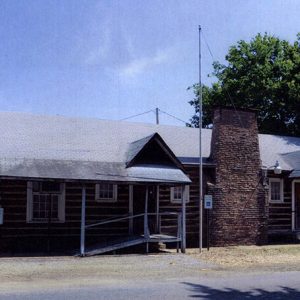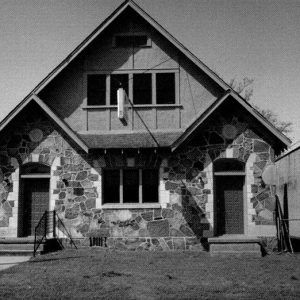calsfoundation@cals.org
Civil Works Administration (CWA)
The Civil Works Administration (CWA) was one of the first federal relief programs under President Franklin D. Roosevelt’s New Deal to provide employment and infrastructure improvements in the depths of the Great Depression.
During this time, U.S. officials realized that the system created by the Federal Emergency Relief Administration (FERA) to fund unskilled-labor jobs through state and local governments to provide employment was not sufficient to combat the worsening effects of the economic depression gripping the country. In response, Harry Hopkins, who was Roosevelt’s federal relief administrator and a proponent of work relief (as opposed to direct relief for the able-bodied unemployed), proposed a new agency to provide jobs. Roosevelt established the Civil Works Administration by executive order in November 1933.
The CWA was always intended to be a short-term agency. Arkansas’s head of emergency relief, William R. Dyess, convened a meeting of the state’s county judges and mayors on November 11, 1933, to explain the new program to them; he asked them to send in applications for projects by November 23. The CWA would provide partial funding for approved projects, with the local sponsors responsible for raising additional funds to ensure project completion—a departure from FERA’s operations in the state, with the federal government providing all of the funding. Fifty county judges and forty mayors attended the meeting, and they submitted hundreds of applications for projects.
The agency commenced operations in Arkansas on November 23, and a week later, 24,419 Arkansas men were on the CWA payroll to work on 884 projects with an approved budget of $4,436,433. By December 15, some 45,457 men were employed by the CWA. At that same time, the Civil Works Service Section (CWS) was established to put Arkansas women to work, immediately providing jobs for 2,199. Initially under the jurisdiction of FERA, the CWS was later moved under the CWA. Peak employment under the programs was achieved in the week ending January 18, 1934, when 67,216 men and 13,104 women were on the payroll, receiving checks totaling $991,009.78 and working on projects valued at around $12 million.
The CWA played a major role in helping Arkansas’s infrastructure recover from the devastating Flood of 1927, which had destroyed many roads and bridges. CWA workers rebuilt roads, constructed culverts, straightened curves, and rebuilt or rehabilitated damaged bridges. Final figures show that $6,196,000 was spent on Arkansas road projects—more than half of the agency’s total expenditures in the state. Forty-two percent of those projects were on county roads, while $1.314 million was spent on street work in cities and towns.
Deteriorating municipal buildings—along with the courthouses in Chicot, Hempstead, Garland, White, Jefferson, and Independence counties—were improved by CWA workers. Airports in twenty-two Arkansas towns were improved at a cost of $122,331. In Washington County, World War I veterans got jobs at Fayetteville National Cemetery and the Veterans Administration hospital, while University of Arkansas (UA) students helped excavate Native American bluff shelters for the University of Arkansas Museum. Local schools for both black and white students were repaired; levees were improved; parks, swimming pools, and Boy Scout camps were constructed or enhanced; and numerous American Legion huts were constructed. Other CWA projects involved malaria control and sanitation projects.
By the time the program was demobilized, the women of the CWS had completed a total of 1,645 projects employing 15,031 people. These projects included 748 sewing rooms that made 108,516 units of children’s clothing, 64,299 units of women’s clothing, and 16,859 units of men’s clothing. A total of 334 projects at canning centers saw the preservation of 89,538 jars of vegetables, 26,630 jars of meat, and 1,951 jars of fruit. Other women were employed at state and local government offices, and at schools, libraries, and hospitals.
The CWA helped increase the pay of Arkansas workers. In 1930, the average weekly pay was $20.34, which had plunged to $13.36 by the first week of January 1934. Three months later, that rate had risen to $14.32.
At the end of 1933, an Investigations and Inspection Section under consulting engineer C. B. Bailey of Wynne (Cross County) was established following complaints that a large number of people who were ineligible for CWA work were employed on CWA projects. An initial group of eighteen investigators, many of them unemployed investigators from the federal Justice Department, began probing the complaints. The extent of the problem soon became apparent, and eleven additional investigators were added to the team. They completed their work on February 15, 1934, and 13,211 ineligible workers were removed from the CWA payroll, with as many as 3,000 others fired by local authorities or quitting on their own after learning of the investigation. Of the 5,217 complaints received, all of which were examined, four were referred for possible federal charges.
On February 15, 1934, while 68,843 Arkansas men and women were employed on CWA projects, the demobilization of the Civil Works Administration was ordered, to be completed by April 1. While it was in operation in Arkansas, the CWA approved and authorized 4,686 projects, of which 1,925 were completed, 2,363 were underway, and 398 had not yet started. A total of $11,290,451.77 was spent, of which $8,622,421.20 went for pages and salaries, and $2,768,030.57 was spent on equipment, materials, and supplies. Unfinished projects were taken over by FERA if supplies were available.
While it existed for a relatively short time, the Civil Works Administration played a key role in Roosevelt’s efforts to bring the United States out of the Great Depression, providing employment for millions across the country while providing needed public works and infrastructure improvements. The CWA’s work was continued by the Works Progress Administration (WPA) after its creation in 1935.
At least fourteen Arkansas properties listed on the National Register of Historic Places are known or believed to have been built through the Civil Works Administration, including the Armstrong-Campbell Post No. 106 in Searcy (White County), listed September 13, 1991; Beely-Johnson American Legion Post 139 in Springdale (Washington and Benton counties), listed May 30, 2007; Bunch-Walton Post No. 22 American Legion Hut in Clarksville (Johnson County), listed January 24, 2007; Estes-Williams American Legion Hut No. 61 in Yellville (Marion County), listed February 16, 2001; Jess Norman Post 166 American Legion Hut in Augusta (Woodruff County), listed October 14, 2001; Sink-Crumb Post No. 72 American Legion Hut in Knobel (Clay County), listed September 25, 2008; and Burson-Bethel Post 119 American Legion Hut in Des Arc (Prairie County), listed June 9, 1995.
For additional information:
Allen, Frank R. CWA Activities in Arkansas, Vol. I. Little Rock: State Emergency Relief Administration, 1934. Special Collections. University of Arkansas Libraries, Fayetteville, Arkansas.
Hope, Holly. An Ambition to be Preferred: New Deal Recovery Efforts and Architecture in Arkansas, 1933-1943. Little Rock: Arkansas Historic Preservation Program, 2006. Online at http://www.arkansaspreservation.com/News-and-Events/publications (accessed February 27, 2021).
Whayne, Jeannie, Thomas A. DeBlack, George Sabo III, and Morris S. Arnold. Arkansas: A Narrative History. 2nd ed. Fayetteville: University of Arkansas Press, 2013.
Mark K. Christ
Little Rock, Arkansas


 American Legion Des Arc
American Legion Des Arc  Harry L. Hopkins
Harry L. Hopkins  Riggs-Hamilton American Legion Post 20
Riggs-Hamilton American Legion Post 20 



Comments
No comments on this entry yet.